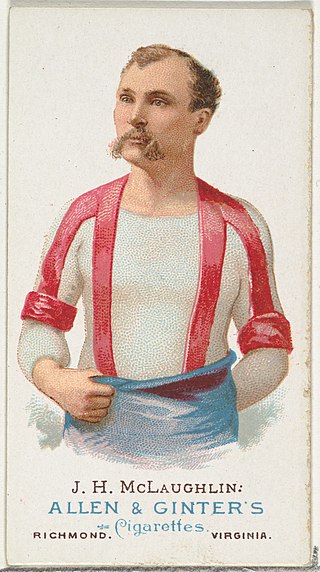McLaughlin Defends Title?
Tuesday, Lub ib hlis ntuj 29, 1884, Kwv yees li ntawm ob txhiab kiv cua crowded rau hauv lub tsev Detroit Opera tsev saib tus thawj ob-match koob ntawm Colonel James H. McLaughlin thiab Henry Moses Dufur. Pawg neeg yuav tsum delight lub koom haum thiab wrestlers. Qhov yuam kev yog nqus crowds nyob rau txhiab tau tsawg tsawg thaum lub xyoo pua 19th.
Organizers claimed McLaughlin was defending the American Collar-and-Elbow Wrestling Champion. McLaughlin had a claim to the American Collar-and-Elbow Championship after defeating John McMahon in the second of their three-match series in 1878. McLaughlin and McMahon drew their third and final match.

Artist rendering ntawm James Hiram McLaughlin (Public sau)
Dufur, McLaughlin, and McMahon were the best collar-and-elbow wrestlers in America during the 1870s and 1880s. All three men held the honorary American Collar-and-Elbow Championship during their careers.
Thaum lub sij hawm no match, McLaughlin and Dufur were both forty years old. McLaughlin outweighed Dufur by fifty pounds. McLaughlin weighed two hundred forty-five pounds. Dufur weighed one hundred ninety-five pounds.
McLaughlin and Dufur entered the ring wearing the required jackets, like a Judo Gi or Sambo jacket. Unlike other matches, the jackets did not come into the decision in any fall during this match.
Ed H. Gillman served as referee. Gillman said the men would wrestle the match according to Ed James collar-and-elbow wrestling rules. Gillman started the match at 8:12 PM.
Dufur preferred grapevines and attacked McLaughlin with grapevine attempts during the first fall. Dufur threw McLaughlin with a grapevine and lift at seven minutes of the first fall. Dufur’s quick pin shocked the crowd and surprised McLaughlin.
Tom 8:37 PM, McLaughlin and Dufur returned for the second fall. Despite Dufur’s one fall advantage, McLaughlin looked confident to start the second fall. McLaughlin led the action by using a hip-lock to toss Dufur to the floor. Dufur turned out of the throw and landed on his stomach.
McLaughlin secured a grapevine and used Dufur’s pet hold to throw Dufur to the mat. Dufur again escaped using a bridge and turn to stand up.
McLaughlin picked up Dufur, swung Dufur in a circle, and dropped Dufur to the mat. McLaughlin extended Dufur’s arm into an armbar. Dufur’s second protested the foul. Gillman warned McLaughlin that he would disqualify McLaughlin for any more fouls.
McLaughlin secured a second grapevine and started to twist Dufur to the floor. Dufur looked about ready to fall when Dufur spun out of the move standing straight up. The crowd cheered Dufur’s athletic escape.
McLaughlin rushed back in and applied a third grapevine. McLaughlin spun and lifted Dufur at the same time. Dufur landed flat on his back as McLaughlin followed Dufur to the ground. McLaughlin pinned Dufur for the second fall in thirteen minutes.
To start the third fall, McLaughlin looked winded. Dufur looked concerned. Despite his great skill, Dufur feared McLaughlin’s size and strength advantage would decide the match. Gillam started the third fall at 9:07 p.m.
McLaughlin provided all the offense during the third fall. McLaughlin applied four grapevines and took Dufur to the mat each time. Txhua lub sij hawm, fans thought McLaughlin had Dufur pinned only for Dufur to escape at the last second. McLaughlin appeared more frustrated after each escape.
Thaum kawg, McLaughlin secured a fifth grapevine but instead of using it to take Dufur down, McLaughlin switched to a hip-lock and threw Dufur flat on his back for the third fall and match at forty-two minutes of the third round.
Dufur asked for a rematch. McLaughlin agreed. It would take the organizers ten months to schedule the final match between the two men. Would the result be any different?
Koj yuav tawm ib saib los nug cov lus nug txog qhov no los yog tej tsev xa rau kuv Facebook phab.
Qhov chaw: Tus Detroit dawb xovxwm (Detroit, Michigan), Lub ib hlis ntuj 30, 1884, p. 1
PIN rau nws
